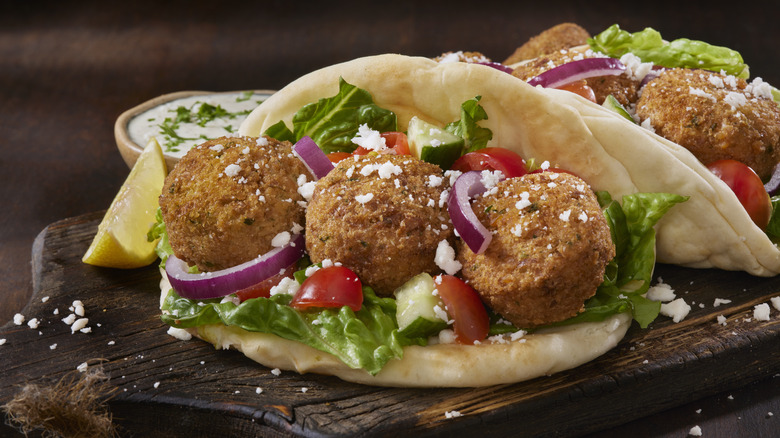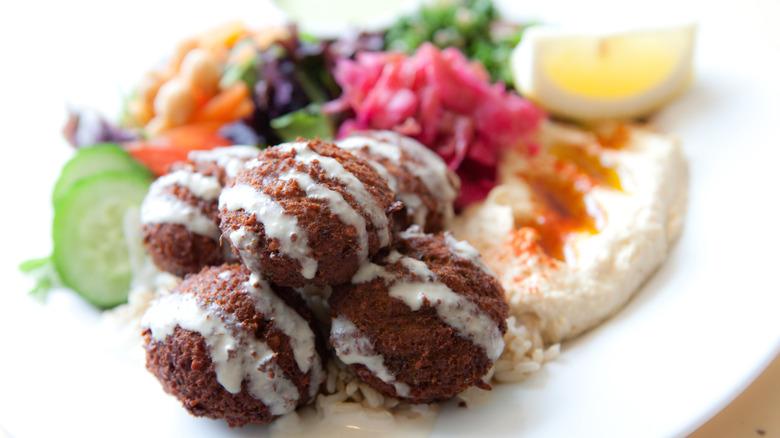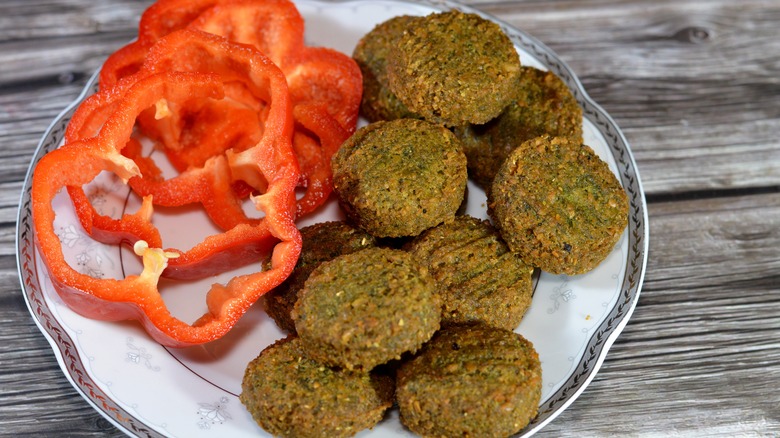What Makes Falafel Different From Ta'ameya?
On the surface, falafel seems like a dish defined by simplicity: tender, little balls of ground chickpea and spices, fried or baked to perfection, using few ingredients and accessible techniques. In actuality, however, falafel has a fraught history with much-contended origins and complex political significance. There has long been debate over which nationality has the right to claim falafel as its own, with Israelis, Palestinians, Lebanese, and Egyptians all embroiled in the argument.
Despite the ongoing debate, historical consensus points to Egypt as the originator of this beloved street food, even if today it's more likely to be associated with cuisines of the Levant. However, the original falafel was a little different than the version that's been popularized worldwide today. Egyptian falafel, now known as ta'ameya, uses fava beans as a base rather than the chickpeas used for the Israeli and Palestinian varietal. If you've eaten falafel from a food stand or Mediterranean restaurant in the United States, chances are you think of it as a chickpea fritter. Though ta'ameya goes by a different name and is not as prominent in the U.S., evidence suggests it was the earliest form of the dish that became known as falafel.
What is falafel?
Though most of the world is familiar with falafel as a fried chickpea patty, it can actually be made from different legumes, and bases vary regionally. In Egypt, where historians agree the dish originated, it is made with fava (also known as broad) beans, whereas Palestinian cuisine uses chickpeas, and in other Middle Eastern countries such as Lebanon, a combination of the two is most common. For a twist with your own falafel recipe try adding pistachios.
In any case, falafel is made from soaked legumes, which are then ground up with spices, herbs, and add-ins like garlic and onion, formed into balls, and deep fried (or sometimes baked). It is commonly served inside a pita sandwich with salad veggies, or as part of a mezze plate with hummus, tahini and perhaps tzatziki. It's popular worldwide as a tasty vegetarian protein source.
The English spelling "falafel" comes from the Arabic "falāfil," which derives from "filfil," meaning "pepper." It's also theorized that the name derived from the Arabic word for fava beans, "fūl." Despite its distinctly Arab (most probably Egyptian) origins, falafel was wholeheartedly embraced by Israeli society as a national icon in the mid-20th century following the state's official establishment, much to the chagrin of their Palestinian and other Arab neighbors. Today, it can be seen not only as a delicious snack, but as a symbol for the Middle Eastern region's complex history of cultural exchange and territorial resentment.
What is ta'ameya?
Simply put, like rectangles and squares, all ta'ameya is falafel, but not all falafal is ta'ameya. Ta'ameya is Egypt's regionally specific variety of falafel, which is traditionally made with fava beans rather than chickpeas. Its name, which has different spelling variations, derives from the Arabic word for food, "ṭaʿām;" its particular diminutive form indicates a small unit, meaning the word roughly translates to "small piece of food."
Ta'ameya is widely believed to be the original form of falafel, preceding the chickpea fritter that went on to gain worldwide notoriety. There are a variety of theories as to its inception, with some positing that it traces back to Ancient Egypt, and others claiming that it was invented by Coptic Christians as a meat-free alternative to satisfy religious dietary requirements. History Today argues that it is likely a "comparatively modern" invention that emerged after British occupation in 1882, inspired by British soldiers' taste for fried vegetable fritters, which they acquired from India.
Ta'emeya is said to have a softer, fluffier texture than chickpea falafel, along with an earthier flavor and greener appearance. It's usually shaped into flatter patties rather than balls prior to frying. It is commonly enjoyed in Egypt as a breakfast food and served with baladi bread, an Ancient Egyptian flatbread.


